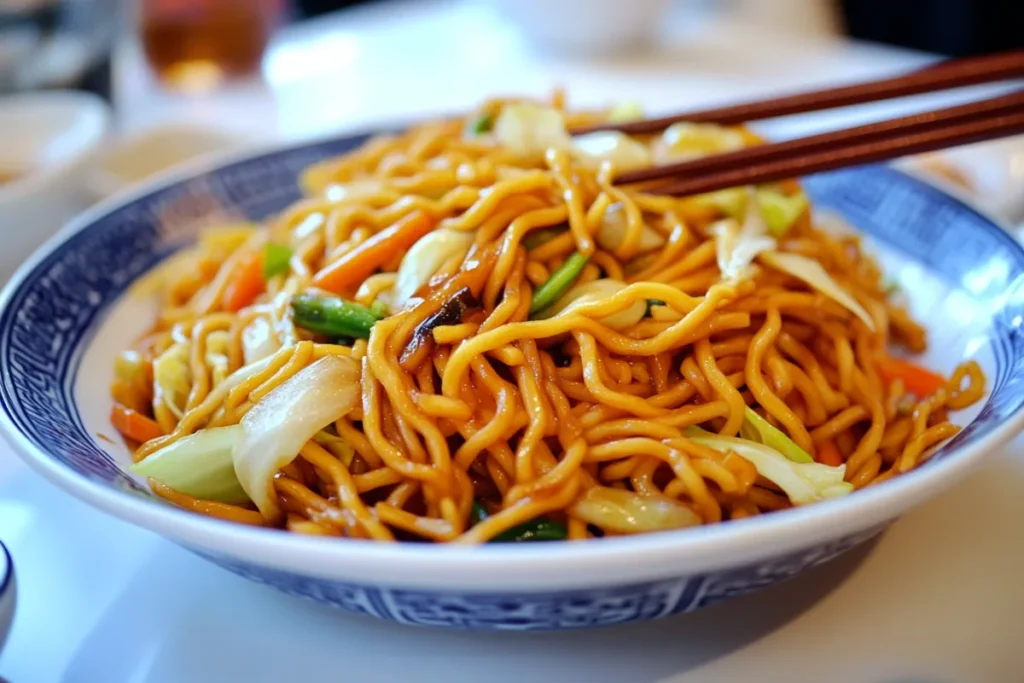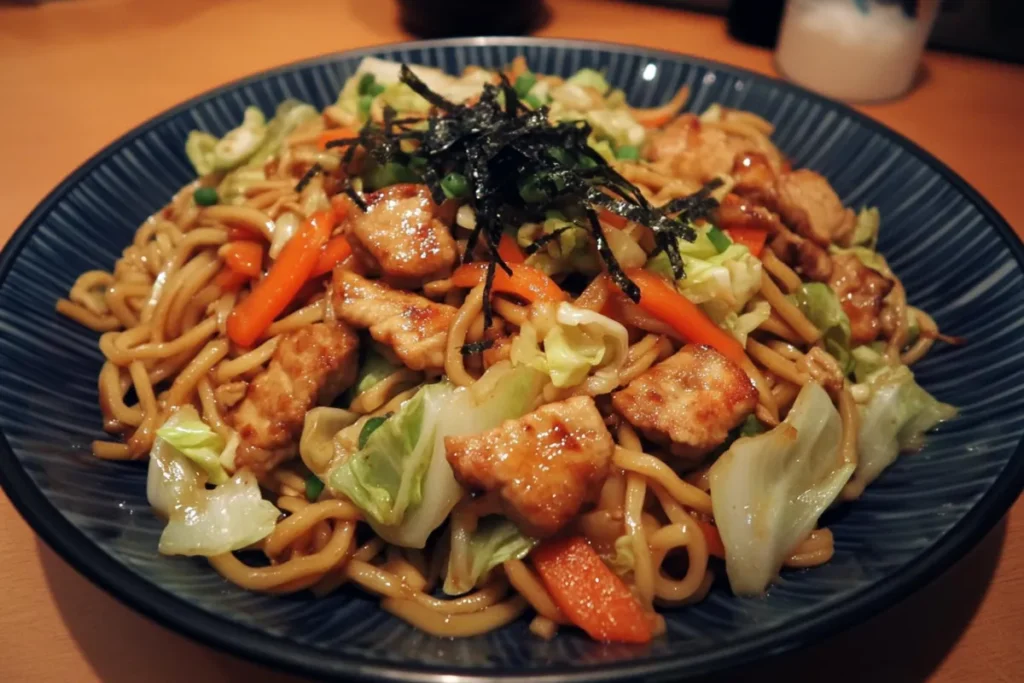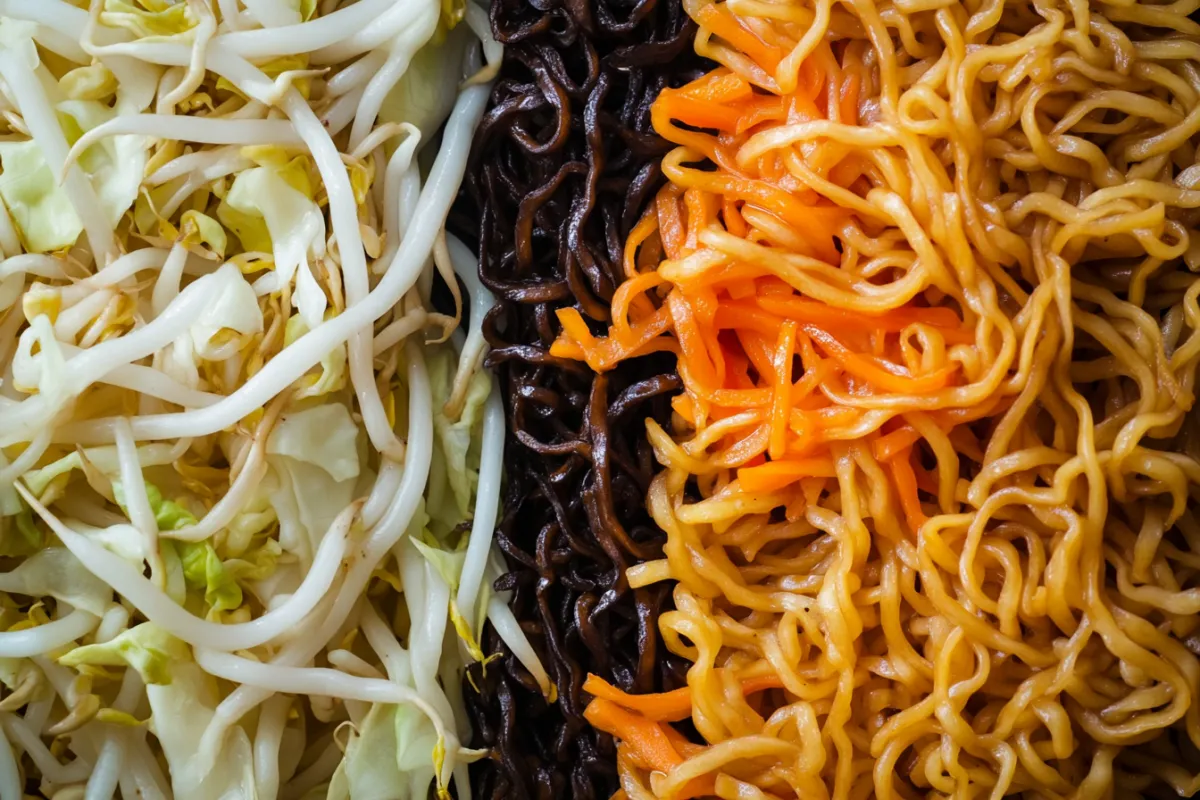What’s the difference between chow mein and yakisoba? These two popular noodle dishes might seem similar at first, but they have different flavors, origins, and cooking styles. In this article, we’ll look at the difference between chow mein and yakisoba, exploring what makes each dish special so you can understand their differences and enjoy their unique backgrounds. We’ll talk about their history, how they are made, the types of noodles they use, and what makes each dish stand out.
If you love Asian food or are just curious about your next takeout meal, learning the difference between chow mein and yakisoba will help you make a better choice and understand their cultural importance. These two dishes are not just different in terms of ingredients; they also tell stories of cultural adaptation and local flavors. Keep reading to learn more about these tasty dishes and how they reflect the cultures they come from!
Origins and Cultural Background
To understand what’s the difference between chow mein and yakisoba, it’s important to start with where they come from. Even though both are well-loved noodle dishes, they have different roots, each with its own history and tradition. Knowing their origins helps us see how these dishes grew and the roles they play in their cultures today.
Chow Mein: A Classic Chinese Dish

- Chinese Origins: Chow mein comes from Chinese cooking. The name means “stir-fried noodles” in Cantonese, which explains how it’s made. Chow mein started as a simple everyday meal but grew into a worldwide favorite.
- Cultural Importance: Chow mein began as a traditional Chinese dish but became popular all over the world, especially in Chinese-American restaurants. It has been changed and adapted to fit different tastes, which has made it one of the best-known dishes representing Chinese cooking. In many places, chow mein is seen as a comforting and versatile dish, with different regions adding their own twists.
- Global Adaptations: Over time, chow mein has developed many different versions, like crispy chow mein and soft chow mein. This flexibility makes it easy to adapt to local tastes, which has helped it become popular everywhere. From street food stalls in Hong Kong to takeout containers in American homes, chow mein keeps changing and growing.
Yakisoba: A Japanese Take on Noodles

- Japanese Twist on Noodles: Yakisoba, even though it has the word “soba” (which usually means buckwheat noodles), actually uses wheat noodles similar to those found in ramen. Yakisoba was inspired by chow mein but was adapted to fit Japanese flavors. This shows how Japan took something from another culture and made it their own.
- Noodle Comparison: To find out whether soba and yakisoba are the same, visit our article Is Soba and Yakisoba the Same?.
- Cultural Significance: Yakisoba is very important in Japanese street food culture. It is often served at festivals, food stalls, and gatherings, showing the fun and social side of Japanese food. Unlike chow mein, which is popular around the world, yakisoba is deeply rooted in Japanese food culture. It’s the kind of dish you find at outdoor summer events, where people gather to enjoy simple yet tasty food that brings everyone together.
Types of Noodles Used
A big part of what’s the difference between chow mein and yakisoba is the type of noodles they use. Even though both dishes have noodles, their ingredients and textures are different. The noodles are the base of both dishes, and their differences are a big reason why chow mein and yakisoba have such distinct flavors and styles.
Chow Mein Noodles: Egg-Based and Versatile
- Egg Noodles: Chow mein is made with egg noodles, which are light and flexible. These noodles are usually boiled first to make them soft, then stir-fried with other ingredients. The egg in the noodles gives them a richer flavor, which tastes great with the savory sauces used in chow mein.
- Texture: Depending on the region and preference, chow mein noodles can be thin and crispy or soft and moist. This flexibility in cooking makes chow mein great for different tastes, leading to versions like Hong Kong-style crispy chow mein and softer versions found in America. The ability to change the texture is one reason why chow mein is so popular—it can be crispy for those who like a bit of crunch, or soft for a comforting meal.
Yakisoba Noodles: Wheat-Based, Stir-Fried Simplicity
- Chinese-Style Wheat Noodles: Yakisoba uses wheat noodles that are similar to ramen, not traditional soba noodles. Even though the name “yakisoba” suggests buckwheat noodles, wheat noodles are actually used. These noodles are thick and chewy, which makes them perfect for stir-frying with the bold sauces that give yakisoba its flavor.
- More About Noodles: Wondering more about the noodles used in yakisoba? Read our detailed article on What Type of Noodles Are Used in Yakisoba?.
- Cooking Method: These noodles are stir-fried without boiling them first, which gives yakisoba its own texture and cooking style. This difference in how they are cooked is one of the main features that sets yakisoba apart from chow mein. Yakisoba noodles soak up the sweet and tangy sauce as they cook, which makes each bite full of flavor.
Preparation and Cooking Techniques
One of the biggest differences when understanding what’s the difference between chow mein and yakisoba is how each dish is cooked. Both dishes are stir-fried, but the methods and ingredients make them unique. These cooking techniques give chow mein and yakisoba their special flavors and textures.
Chow Mein: Boiled Then Fried
- Double Cooking Method: Chow mein is usually made by boiling the egg noodles first to make them soft. Then they are stir-fried with vegetables, proteins, and seasonings. This two-step process makes the noodles soft inside while still giving them some crispy edges when fried.
- Variations in Texture: Depending on how long the noodles are fried, chow mein can be soft and tender or crispy and crunchy. This difference, based on regional or personal tastes, gives chow mein a lot of options. You can enjoy chow mein in many ways—whether it’s soft like a stir-fry or crispy like a noodle pancake.
- Ingredients: The dish usually has vegetables like bean sprouts, cabbage, and carrots, along with proteins like chicken, beef, or shrimp. You can easily change the ingredients to suit your taste or what you have available. This flexibility makes chow mein great for using up leftover vegetables or customizing to your favorite flavors.
Yakisoba: Quick Stir-Fry, Festival Favorite
- Stir-Fried Simplicity: Unlike chow mein, yakisoba noodles are stir-fried right away without boiling. This makes it quick to cook, which is why yakisoba is popular at food stalls. The simple stir-fry process means that the dish can be prepared fast, making it ideal for feeding crowds at festivals.
- Key Ingredients: Yakisoba is usually made with vegetables like cabbage, carrots, and onions. It is often cooked on large griddles, which makes it easy to cook a lot at once and gives it a bold, tasty flavor. The vegetables are cooked until they are tender but still a bit crisp, giving a nice contrast to the noodles.
- Yakisoba Sauce: Want to know more about the key flavors in yakisoba? Check out What Is Yakisoba Sauce Made Of?.
- Street Food Appeal: The quick cooking time and strong flavor make yakisoba a festival favorite in Japan. Seeing yakisoba cooked at food stalls is a common part of Japanese festivals. The smoky smell and the sound of noodles sizzling on the griddle add to the festive feel, making yakisoba more than just a meal—it’s an experience.
Key Ingredients and Flavor Profile
The different flavors of chow mein and yakisoba come from the unique sauces and ingredients used in each dish. Understanding these flavors is key when comparing the two. The sauces and toppings are what give each dish its special taste, making them truly unique.
Chow Mein: Savory Soy and Oyster Sauce
- Seasoning Sauces: Chow mein is mainly flavored with soy sauce or oyster sauce, which gives it a savory taste. Depending on the recipe, spices and other sauces can be added to change the flavor. This mix of sauces provides a deep, rich taste that goes well with the egg noodles and vegetables.
- Flavor Characteristics: The seasoning in chow mein is flexible. Ingredients like garlic, ginger, and green onions can make it taste even better. Whether you prefer a light soy flavor or a stronger oyster-based sauce, chow mein’s versatility makes it appealing to many people. It can easily be adjusted to be more savory, spicy, or even a bit sweet, depending on your taste.
Yakisoba: Sweet and Tangy Sauce
- Signature Sauce: Yakisoba gets its flavor from a sauce that is like Worcestershire sauce but with a sweet and tangy twist. This sauce makes yakisoba taste unique and different from chow mein. The sauce is both sweet and slightly sour, making it very different from the savory taste of chow mein.
- Toppings and Garnishes: The dish is often topped with garnishes like pickled ginger or seaweed flakes (aonori), which add extra flavor and texture. The mix of sweet, tangy, and umami flavors makes yakisoba stand out from chow mein. The pickled ginger adds some sharpness, while the seaweed adds an earthy note that brings all the flavors together.
Cultural Significance and Adaptations
Learning about the cultural significance of chow mein and yakisoba helps explain what’s the difference between chow mein and yakisoba beyond just flavors and cooking styles. These dishes are an important part of their cultures, each with its own special meaning and tradition.
Chow Mein: A Chinese Favorite Around the World
- A Cultural Staple: Chow mein is a key dish in China and has become popular all over the world. Its popularity in Chinese-American cuisine shows how adaptable it is and the influence of Chinese culture on food. From high-end restaurants to small takeout places, chow mein represents Chinese cooking in many parts of the world.
- Regional Variations: There are many different versions of chow mein, each using local ingredients and flavors. For example, Cantonese chow mein tends to be crispier, while Szechuan chow mein can be spicier, depending on local tastes. Each version of chow mein tells a story about the region it comes from, showing the diversity of Chinese food.
Yakisoba: A Japanese Comfort Food
- Festival Food: Yakisoba is closely tied to Japanese festivals and gatherings. It is often made on large griddles at festivals, which shows the fun and social side of these events in Japan. Eating yakisoba at a festival, where people gather around food stalls, is a big part of its cultural charm.
- Comfort Dish: Yakisoba is also a comfort food in Japan, often made at family events. Its sweet-savory flavor brings a feeling of comfort and nostalgia, especially during festivals. It’s a dish that many people in Japan grew up eating, and its flavors often remind them of happy times at festivals or family gatherings.
Summary Table of Differences
To make the differences between chow mein and yakisoba clearer, here’s a detailed comparison:
| Feature | Chow Mein | Yakisoba |
|---|---|---|
| Origin | Chinese cuisine | Japanese cuisine |
| Noodles | Egg noodles | Chinese-style wheat noodles |
| Preparation | Stir-fried after boiling | Stir-fried directly |
| Main Ingredients | Varied vegetables & proteins | Cabbage, various vegetables |
| Sauce | Soy sauce or oyster sauce | Sweet Worcestershire-style sauce |
| Cultural Role | Global staple in Chinese cuisine | Popular street food in Japan |
Conclusion
So, what’s the difference between chow mein and yakisoba? While both dishes are loved as stir-fried noodles, they have different origins, noodles, flavors, and cultural meanings. Chow mein, from China, can be soft or crispy and is flavored with savory soy or oyster sauce. Yakisoba, from Japan, has a sweet and tangy flavor and is closely tied to Japanese street food culture.
If you’re looking for more comforting and easy recipes, check out our Loaded Fries Recipes for another fun and flavorful option.
Next time you’re deciding between chow mein and yakisoba, think about the taste and the rich traditions behind them. Whether you want the crispiness of chow mein or the sweet tang of yakisoba, both dishes offer delicious flavors and unique cultural stories. Each dish has a story to tell, from the bustling streets of Chinese-American neighborhoods to the festive gatherings in Japan. Choosing between them means choosing a little bit of history and culture with every bite.
PrintChow Mein vs Yakisoba: Understanding the Differences
- Total Time: 35 minutes
- Yield: 4 servings
- Diet: Vegetarian
Description
Explore the differences between chow mein and yakisoba, two popular noodle dishes with distinct origins, flavors, and cooking styles.
Ingredients
- Egg noodles (for Chow Mein)
- Chinese-style wheat noodles (for Yakisoba)
- Vegetables (bean sprouts, cabbage, carrots)
- Protein options (chicken, beef, shrimp)
- Soy sauce or oyster sauce (for Chow Mein)
- Sweet Worcestershire-style sauce (for Yakisoba)
- Pickled ginger and seaweed flakes (for Yakisoba garnish)
Instructions
- For Chow Mein: Boil egg noodles until soft, then stir-fry with vegetables and protein, adding soy or oyster sauce for flavor.
- For Yakisoba: Stir-fry wheat noodles directly with vegetables on high heat, incorporating sweet Worcestershire-style sauce for taste.
- Serve Chow Mein with a crisp or soft texture depending on preference. Serve Yakisoba garnished with pickled ginger and aonori.
Notes
Chow Mein offers versatility in texture while Yakisoba showcases Japanese street food culture. Customize both dishes with your choice of proteins and vegetables.
- Prep Time: 15 minutes
- Cook Time: 20 minutes
- Category: Main Course
- Method: Stir-frying
- Cuisine: Asian
Nutrition
- Serving Size: 1 serving
- Calories: 400
- Sugar: 8g
- Sodium: 800mg
- Fat: 15g
- Saturated Fat: 3g
- Unsaturated Fat: 9g
- Trans Fat: 0g
- Carbohydrates: 55g
- Fiber: 4g
- Protein: 14g
- Cholesterol: 50mg
Keywords: chow mein, yakisoba, noodles, Asian cuisine, stir-fried noodles, comfort food

